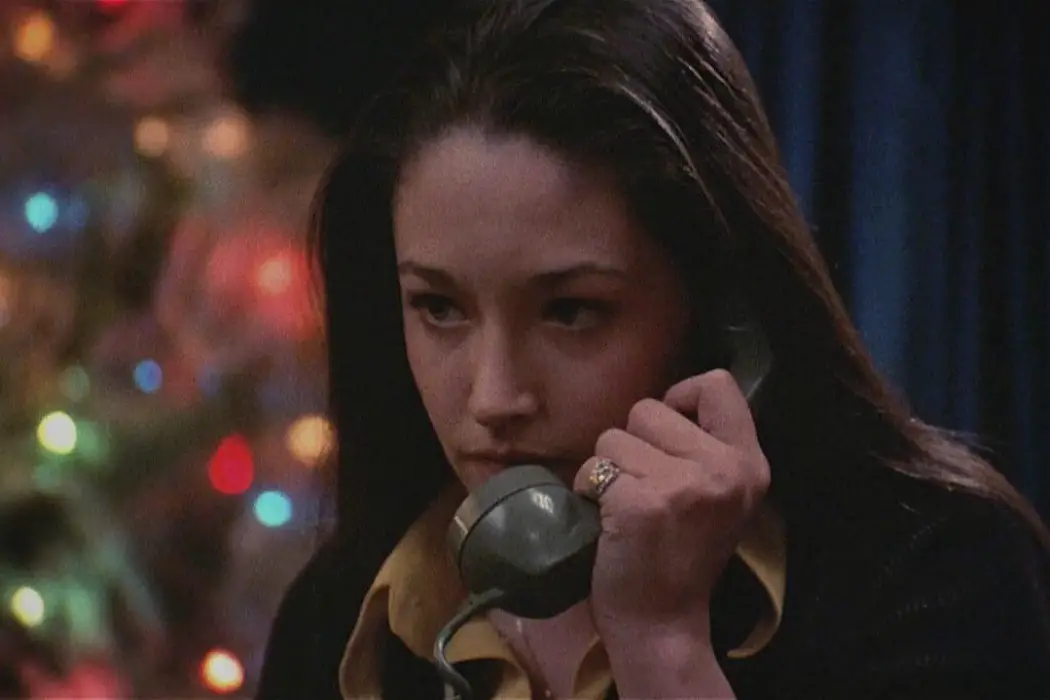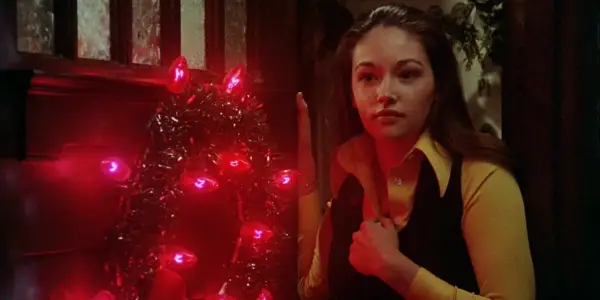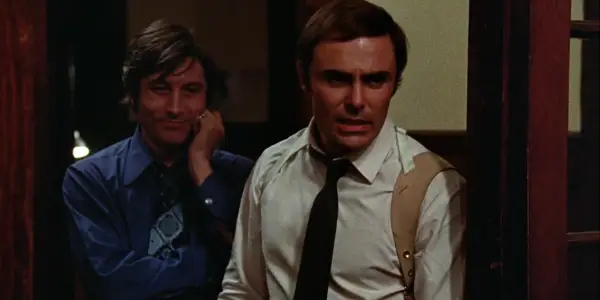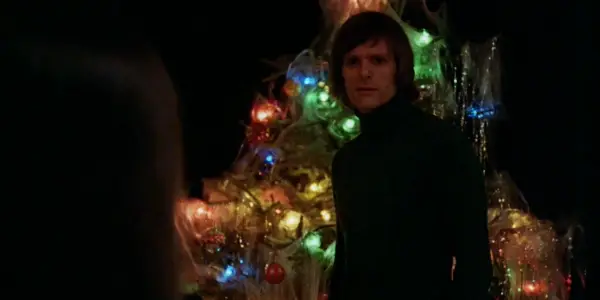The 1974 BLACK CHRISTMAS Brought Giallo To America, And Nobody Was Ready

Film critic, Ithaca College graduate, University of St Andrews masters…
In Italy, from the mid-1960s to the 1980s, the Giallo film was inescapable. Named for the yellow book covers of old dimestore detective novels, the genre favors knife-wielding killers, murder mysteries, espionage plots, topless women, and buckets of blood and gore. In the 30-year hot streak of the Giallo, Italian filmmakers pumped out hundreds of these. They built on what horror had come before and laid the foundations for the slasher genre to come. And in doing so, they also likely inspired Black Christmas, the 1974 Canadian holiday slasher classic that tried to bring the genre to the West. Nobody was ready for it, though, making Black Christmas a misunderstood trailblazer, a film ahead of its time.
How Black Christmas Started The Slasher Trend
Black Christmas predates the American slasher by a few years, coming before such subgenre startups as Halloween and Friday the 13th. The Texas Chain Saw Massacre premiered the same year, but — debate me in the comments if you’d like — Black Christmas contains much more “American slasher” DNA. Black Christmas follows a group of sorority girls who, just before the college’s holiday break, receive threatening and scary phone calls from a stranger while he kills them one by one in their sorority house.
The film is directed by Bob Clark, his second horror film and also his last. He would go on to direct, rather incongruously, Porky’s, A Christmas Story (another holiday classic!), and the two Baby Geniuses films. But in Black Christmas’ blend of sadism, camp and scantily clad women, the film finds the pulse of the American slasher much sooner than the comparatively Grand Guignol and dismal Texas Chain Saw.
In contrast to Italian slashers, the cast of Black Christmas is mostly teenagers — attractive young women presented as both eye candy and objects to be tortured, a common theme throughout American slashers. The closest giallo got to such a cast is Mario Bava’s sloppy and nihilistic 1971 film A Bay of Blood, which kind of has a teenage cast but then murders them all before the third act. It would go on to be one of the main inspirations for Friday the 13th. Puritanically, the women in Black Christmas, as in Friday the 13th and A Bay of Blood, are painted as frivolous, materialistic, alcoholic and horny, as if to justify their murders with supposedly loose morals. The emphasis on female sexuality in Clark’s film isn’t only subtext: “I know a professional virgin when I see one,” Margot Kidder’s iconically droll sorority girl says. (Most of her jokes in the film have to do with sex.)

Wintry settings are out of place among Giallo films, too. And stylistically, Black Christmas isn’t horrendously and comically dubbed into English, so that’s another big difference. Yet most striking of all is that focus on female sexuality and young female protagonists, which isolates this film among its Giallo forebearers — the mystery is such a nonelement, and the detectives are so lousy at solving it anyway that I can’t imagine Black Christmas being sold as a dimestore detective novel in the first place.
Giallo Roots
For all its familiar Giallo DNA, the most affable and handsome starting point is John Saxon. Saxon, a charming, muscular B-list star who combines James Mason’s looks with Anthony Perkins’ boyish enthusiasm and Robert Redford’s easy smile and good humor, plays the police lieutenant in Black Christmas. The actor spent 1962 through 1993 alternating between Italian and Hollywood productions. Among them, he made The Girl Who Knew Too Much with Mario Bava — considered one of the first Giallo films — as well as other gialli such as The Scorpion with Two Tails, Dario Argento’s Tenebrae, and Umberto Lenzi’s Nightmare Beach. (Saxon also wears a stylish hat throughout Black Christmas and then spends all of Tenebrae trying on various Italian hat designs to impress his friend.) Saxon’s presence in Black Christmas reminds us of the slasher film’s roots, of the Italian genre’s reliance on strong male figures coming up against unspeakable crimes and brutal killers, and of the American genre’s minimization of these figures in favor of splatter deaths and final girls.
Giallo films follow a familiar rhythm — they often open with a protracted, violent, over-the-top murder, then sprinkle a few more throughout the runtime. Not only does Black Christmas follow that structure, but it does so from the killer’s point of view. We become the murderer for the film’s first few minutes as they sneak up the side of the sorority house, enter the loft window, and make their first kill. This is a motif that Giallo films picked up from slasher progenitors Psycho and Peeping Tom, which rely on POV to both conceal the identity of the killer and to indulge a dark voyeurism in their audiences.

The murderer in Giallo films is always kept a secret. You never get a good look at the killer in Black Christmas, and the voice they use over the phone is deliberately schizophrenic. The killer’s terrifying mishmash of voices, including a screaming woman, weird tongue flapping, and a creepy male intonation, makes them sonically androgynous. (Argento used the slobbering, giggly speeches over the phone, too, in 1970’s The Bird with the Crystal Plumage.) For the Giallo, this androgyny kept the audience guessing. But for the slasher, there’s no real mystery at play, and the identity of the killer doesn’t matter. The genderlessness and the unknowability, combined with the overt threat of violence, make the slasher villain less a character and more an amorphous embodiment of evil.
Hyperviolence and hyper-stylized murder sequences are paramount to the giallo’s appeal. Characters and plot always come second to aesthetics. In Black Christmas, Clark uses naturalistic chiaroscuro lighting and the eerie polychromatic ambiance of holiday fairy lights to set the stage. The murder scenes are delightfully expressionistic, too. The housemother (Marian Waldman) getting hooked in the attic; the brutal unicorn statue stabbing; and the final chase through the house each evoke the Giallo tradition of one-upmanship. Black Christmas’ kills are every bit as singular and creative as its Italian ancestors, even if they do have a tinge of grit and naturalism to them where the Giallo always would rather go with garish color and over-the-top violence.
The Horrors Of Modernity
Giallo films often depict modern life as a hellhole — the man trapped in the entryway in The Bird with the Crystal Plumage, helplessly watching a woman murdered in front of him. Or the comically industrialized chicken farm in Death Laid an Egg, or the foreboding hallways of the pharmaceutical company in The Cat o’ Nine Tails. Our image of labyrinthine industrial life in Black Christmas comes when the cops are hot on the trail of the killer, during a tense sequence that revolves around the guy at the phone company trying to trace the killer’s call.

Tonally, too, Black Christmas emulates Giallo films. It’s really mean-spirited — ”Ho, ho, ho, shit,” says a frat guy dressed as Santa. In the first scene with a dead girl’s father (James Edmond), a stray snowball hits him in the face and knocks his glasses off. Even the comic interludes, mostly featuring Waldman’s or Kidder’s characters or the screw-up policeman (Doug McGrath), feel less funny and more just plain cruel.
There’s a dark unpredictability to the film as well. Its lead (Olivia Hussey) begins poised, sophisticated, and straight-laced, only to slowly unravel over the film. The pianist’s boyfriend (Keir Dullea) violently shatters his piano, the killer has an inhuman, animalistic freak-out in the attic, and the unicorn statue stabbing comes off as overtly sexual in a disarming way. The missing girl, suffocated in the attic, is the focal point of a search that never gets resolved, but she’s always up there if anyone looks in the right window.
The killer’s resignation to the attic doubles as a metaphor for the trauma that drives him to kill. Black Christmas is concerned with its killer’s psychology, but only up to a point. Most end with the killer having a plausible motive — money, revenge, love. Black Christmas never gets resolved — the killer is never caught, the girl in the attic never found, and most importantly, his motivations are left open-ended. There’s no grand psychological sermon at the end a la Psycho or Peeping Tom. After 15 years of telling the same psycho killer stories, the film finally decides that there’s no easy way to explain away horrible, violent murders or any coherent way to understand them… Black Christmas and Bob Clark decide such things are to remain a mystery.
The film is now recognized as a classic, one that helped spawn the slasher genre, but I think it’s more specific in its accomplishments than that — it brought Giallo stylings to America. So what did critics and audiences think of it at the time? Surely upon release, it was well-received and beloved….
Everyone Hated This Movie
Turns out, a dark, cynical movie about dead college girls around the holidays doesn’t sell well. Every perk of the film turned to detractors in the eyes of its critics: A New York Times review of the movie said, “Why this skulking psychopath is driven to making explicitly obscene phone calls in a variety of crazed voices to the girls before dispatching them remains a fairly foggy business” — despite that this is the point of the story! The ambiguity of evil in Black Christmas is part of why it’s so terrifying. Another review, in Variety, called the movie a “bloody, senseless kill-for-kicks feature” that “exploits unnecessary violence” against the sorority girls, begging the question of what the critic was expecting when they bought their ticket.

Giallo films never did well in the states when they were originally released, nor did Peeping Tom when it was first released in 1960. Black Christmas recuperated its budget but was pulled from release after about five weeks in a time when successful films stuck around the marquee for months.
Conclusion:
Doomed to be constantly retitled for theatrical and television runs, Black Christmas would have remained in obscurity were it not for its fans and critics who have reappraised it in recent years. Black Christmas retains much of its power in 2021 — not only is the film scary as hell, but it also carries characteristically giallo-brand messages about the failures of police to keep us safe, the persistence of evil, the corruption of the homestead, and of course, the horror of modernity.
Despite its ignominious reception in 1974, the film, it seems, has finally found its audience — and in doing so, it’s become a fascinating archaeological project, as a missing link between the Italian giallo and the American slasher. It drew from the Italian films because there had been nothing else like Black Christmas in the West. It’s the perfect marriage, Italian style, of bright red blood, expressionistic kills, and surreal lighting design with a young female cast, 1970s American cynicism, and one motiveless killer lying in wait in the attic.
What do you think of Black Christmas? Do you agree that it’s the missing link between Italian giallos and American slashers? Let us know in the comments.
Does content like this matter to you?
Become a Member and support film journalism. Unlock access to all of Film Inquiry`s great articles. Join a community of like-minded readers who are passionate about cinema - get access to our private members Network, give back to independent filmmakers, and more.
Film critic, Ithaca College graduate, University of St Andrews masters student, head of the "Paddington 2" fan club.













